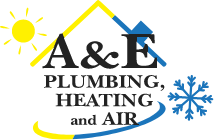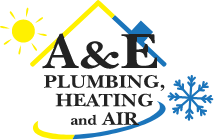Top 3 Duct Sealing Solutions Eligible for Inflation Reduction Act (IRA) Tax Credits
September 19th, 2024
5 min read
By Daphne Hunt
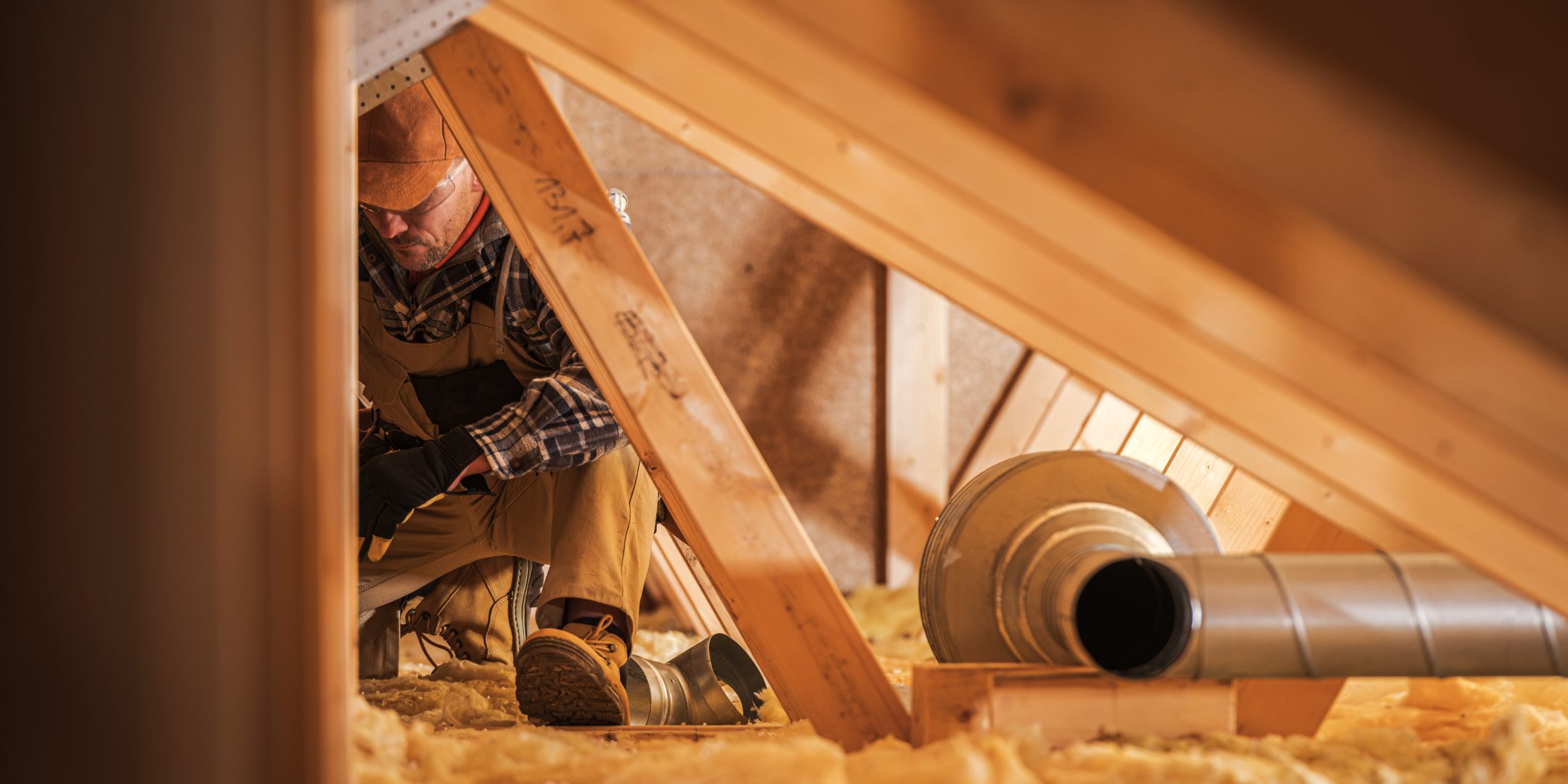
When your HVAC system isn’t working efficiently, it can result in higher energy bills and inconsistent comfort throughout your home. One of the main culprits for these issues is leaky ductwork, which causes your system to lose conditioned air and forces it to work harder than necessary. The result? Wasted energy, increased wear and tear on your HVAC unit, and a less comfortable living environment. You may be unsure how to solve this issue while keeping costs manageable.
With over 16 years of experience in the HVAC industry, we’ve seen how duct sealing can dramatically improve the efficiency of heating and cooling systems. Our deep understanding of energy-efficient solutions allows us to guide homeowners through finding the right duct sealing options for their needs. We know what works, and how to ensure your home is sealed properly to reduce energy waste and enhance comfort—all while benefiting from financial incentives under programs like the Inflation Reduction Act (IRA).
By the end of this article, you’ll have a clear understanding of the top duct sealing methods, and how each one qualifies for tax credits under the IRA. We’ll provide you with actionable information on the best sealing options—whether it’s a DIY solution like mastic sealants or a professional service like Aeroseal—so you can make an informed decision and start saving money immediately on your energy bills.
Mastic Sealants for Duct Sealing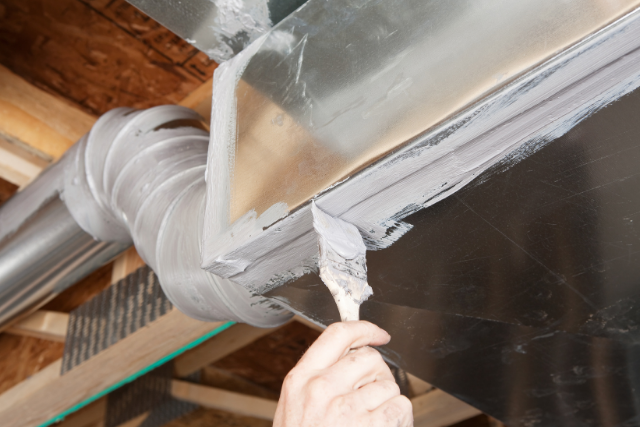
Mastic sealants are a reliable, paste-like material used to seal duct joints and seams, creating a durable and long-lasting barrier against air leaks. This material hardens after application, providing a seal that can last 15-25 years, making it an excellent long-term solution for improving HVAC system efficiency. Mastic is highly effective at preventing air loss, reducing energy waste, and maintaining indoor comfort by ensuring that conditioned air reaches its intended destination.
Key Features
- Durable Seal: Mastic is known for its durability, providing a seal that can last for decades with proper application.
- Versatility: It can be applied to various types of duct materials, including metal, fiberglass, and flexible ducts, making it suitable for a range of systems.
- DIY-Friendly: Homeowners can apply mastic themselves using simple tools like a paintbrush or caulk gun, making it an accessible option for those looking to reduce labor costs.
- Moisture Resistance: Mastic is also water-resistant, ensuring that the seal remains intact even in areas exposed to humidity.
General Price Point
A half-gallon of mastic typically costs around $30-$40, and with basic tools like a paintbrush or caulk gun, the total cost for a small project is relatively low — usually under $60 for most DIYers. This makes mastic one of the more cost-effective options for long-term duct sealing.
Downsides
- Messy Application: Mastic can be challenging to apply neatly, especially in tight or hard-to-reach spaces. It requires careful, even application to be effective, and cleanup can be difficult if it gets on unintended surfaces.
- Time-Consuming: Compared to quick fixes like foil tape, applying mastic is more labor-intensive and requires drying time to set properly, which can delay other work on your HVAC system.
Best For
Mastic is ideal for homeowners who want a long-term, cost-effective solution for sealing moderate-to-large leaks in accessible ductwork. It’s great for those comfortable with DIY projects and willing to invest the time for proper application. If you're dealing with ducts in open areas like attics or basements, mastic offers a durable, lasting fix that will reduce energy loss and improve your HVAC system's overall efficiency.
Sealing Ducts with Foil HVAC Tape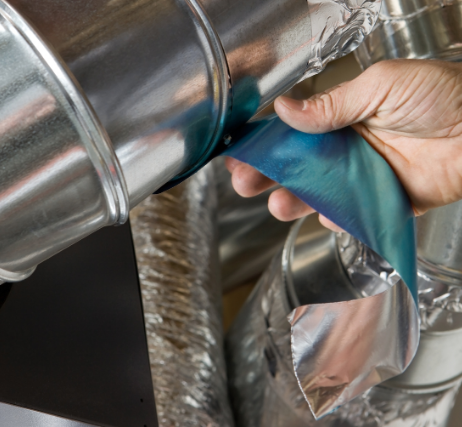
Foil HVAC tape is a practical and easy-to-use option for sealing small leaks or cracks in ductwork. Unlike traditional duct tape, which can degrade over time, foil tape is designed specifically for HVAC systems, providing durability and heat resistance. It is a quick, affordable solution for minor ductwork repairs, making it a popular choice for homeowners looking for an efficient, temporary fix.
Key Features
- Heat-Resistant: Designed to withstand the high temperatures produced by HVAC systems, foil tape won’t degrade as regular duct tape would.
- Easy Application: The tape can be easily cut and applied without the need for special tools, making it a perfect choice for DIY projects.
- Flexibility: It can be used on metal, fiberglass, and flexible ducts, giving it versatility for various types of duct systems.
General Price Point
A roll of foil HVAC tape costs around $15, making it a cost-effective solution for homeowners looking for a quick and simple fix. Most minor leaks can be sealed for under $30, depending on the size of the repair.
Downsides
- Limited Durability: Foil tape doesn’t offer the same long-term protection as mastic sealants. It may require reapplication over time, particularly in areas with large or complex leaks.
- Best for Small Gaps: Foil tape is not suitable for sealing larger leaks or gaps in ductwork, as it doesn’t provide the same level of durability as other solutions like mastic.
Best For
Foil HVAC tape is best for homeowners looking for a fast, affordable fix to seal small leaks in accessible ductwork. If you need a temporary solution or have small, easily reachable gaps in your system, foil HVAC tape provides an easy and efficient way to seal them. However, for larger, long-term issues, a more durable option like mastic or Aeroseal might be needed.
Foil tape is perfect for those quick repairs where you want to improve efficiency without investing much time or money, though you should be aware that it’s not as long-lasting as other options.
3. Aeroseal Duct Sealing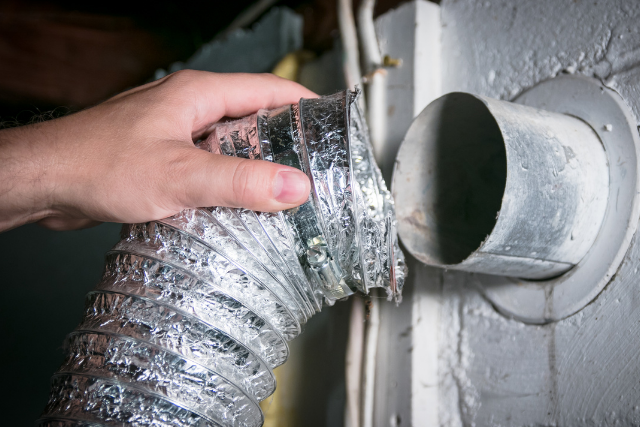
Aeroseal is an advanced, professional duct sealing method that uses a high-tech pressurized system to locate and seal leaks from the inside. This method is particularly effective for comprehensive sealing, as it allows technicians to target leaks in both accessible and hard-to-reach areas of the duct system. The aerosolized sealant used by Aeroseal fills gaps from within, ensuring up to 95% of leaks are sealed, making it one of the most thorough solutions available.
Key Features
- Comprehensive Sealing: Aeroseal seals leaks in both visible and hidden areas, ensuring that up to 95% of all duct leaks are sealed, offering unmatched coverage compared to other methods.
- Enhanced Energy Efficiency: By sealing the entire duct system, Aeroseal can greatly improve HVAC efficiency, which translates to lower energy bills and better temperature regulation throughout the home.
- Improves Indoor Air Quality: Aeroseal’s sealing process prevents contaminants like dust, allergens, and pollutants from entering the ductwork, leading to cleaner air circulating in the home.
General Price Point
Aeroseal is a professional service, and the costs reflect its high-tech nature. On average, homeowners can expect to pay around $3,000 to $6,000 for an Aeroseal service, depending on the size of the home and the complexity of the duct system. While this makes Aeroseal the most expensive duct sealing option, the energy savings and improved air quality often justify the cost for many homeowners.
Downsides
- High Cost: The upfront cost of Aeroseal is significantly higher than DIY methods like mastic or foil tape, making it less accessible for homeowners on a tight budget.
- Professional Installation Required: Aeroseal is not a DIY solution, and it requires the expertise of an HVAC technician who is certified in the Aeroseal process, adding to the overall expense.
Best For
Aeroseal is best for homeowners with older, complex, or inaccessible duct systems who want a comprehensive, long-term solution to reduce energy waste and improve HVAC efficiency. It’s also ideal for those with serious air quality concerns, as the process eliminates leaks that could be introducing contaminants into the home. While expensive, Aeroseal offers the highest level of sealing performance available, making it worth the investment for long-term energy savings and comfort improvements.
How to Apply for Tax Credits and Rebates for Duct Sealing Costs
To reduce the cost of your duct sealing project under the Inflation Reduction Act (IRA), follow these steps:
- Ensure Eligibility: Verify that your duct sealing method (mastic, Aeroseal, etc.) meets the IRA’s energy-efficiency standards. Obtain a Manufacturer’s Certification Statement.
- Save Documentation: Keep receipts for materials, contractor invoices, and certification statements.
- File IRS Form 5695: Claim the 30% tax credit for your project (materials and labor), capped at $1,200 annually.

Choosing the Right Duct Sealing Option for Your Home
When you first thought about duct sealing, you were probably feeling concerned about energy loss and rising utility bills. It can be overwhelming to figure out the best way to tackle the issue, but now that you have a better understanding of the top different sealing options, you’re equipped to make a smart, cost-effective choice for your home.
With the Inflation Reduction Act (IRA) offering tax credits for energy-efficient upgrades like duct sealing, now is the perfect time to take action. By choosing the right method and applying for these savings, you can reduce your costs even further. With our 16+ years of experience, our team of experienced HVAC techs are on standby to help, ensuring your duct sealing project is handled efficiently and effectively.
Ready to choose a duct sealing method? Learn more about why Aeroseal leads the pack in our full review on its benefits and costs.
Daphne Hunt holds a bachelor's degree in English and Mass Communication and has a lifelong passion for writing. She thrives on using her skills to craft compelling pieces that inform, inspire, and connect with readers.
Topics:
